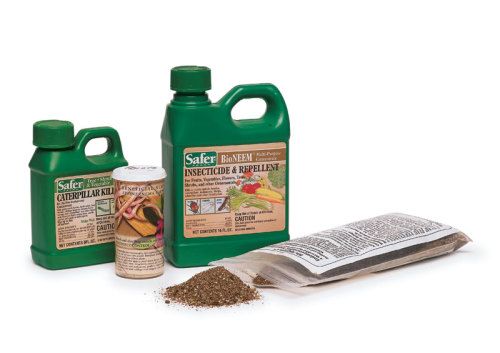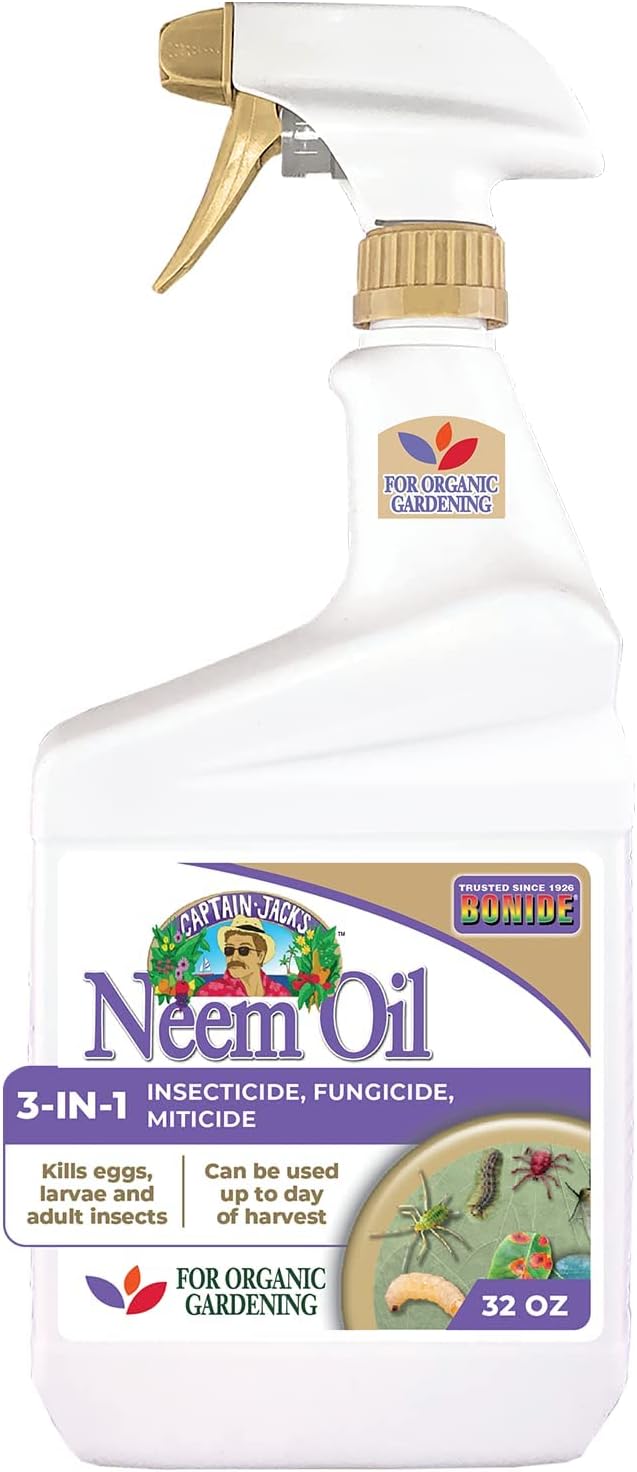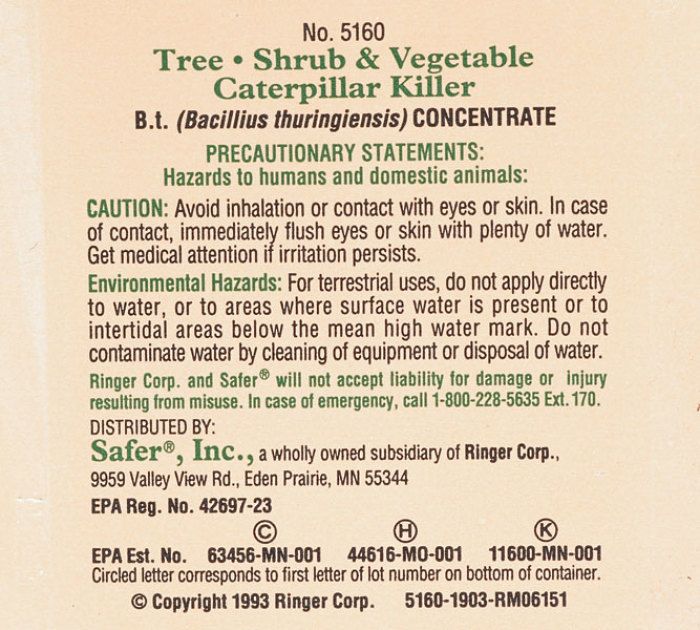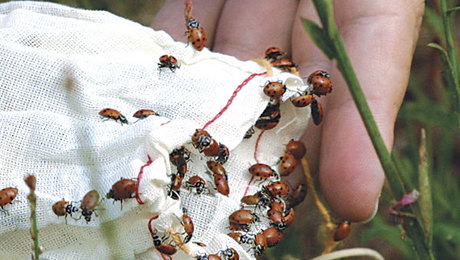
by Helga Olkowski
April 1998
from issue #14
When insect pests attack the kitchen garden, savvy gardeners turn first to non-chemical methods to prevent plant damage. On occasion, however, a pesticide is needed to augment physical controls like traps, row covers, plastic mulches, and help from predatory insects. When faced with the need to use an insecticide, here are a few guidelines.
In general, you want to select an insecticide that has some or all of the following characteristics: low toxicity to humans and wildlife, selective toxicity to specific pest species while being nontoxic or less harmful to beneficial organisms, good biodegradability, and low mobility with little likelihood of contaminating surface or groundwater.
Fortunately, the list of least-toxic insecticides has been growing. Biological insecticides derived from plants are called botanicals; those derived from microorganisms like fungi, bacteria, and nematodes are called microbials. Like conventional synthetic insecticides, these products are most effective when used in combination with nonchemical methods, and should be applied as spot treatments when pest numbers threaten to exceed your tolerance level, rather than indiscriminately throughout your garden.
The biologicals mentioned are currently registered by the U.S. Environmental Protection Agency for use on pests that attack both food crops and ornamentals. Since EPA registrations change frequently, check the label to ensure the product continues to be registered for use in the kitchen garden. Remember that biological insecticides may contain living organisms, so store them in a cool, dark area or refrigerate them. They will die if exposed to excessively cold or hot temperatures.
Neem oil comes from a tree. This botanical insecticide is prepared from extracts of oils from seeds of the tropical neem tree, Azadirachta indica, native to India and the Asian subcontinent. Neem oil is effective against leaf-chewing and sucking insects including aphids, beetle larvae, caterpillars, leafminers, leafhoppers, thrips, and whiteflies.
This product has several modes of action against insects. Primarily it acts as an insect growth regulator, meaning it prevents pre-adult insects from successfully molting from the juvenile to adult stage. Treated larval and pupal insects stop feeding and die without reproducing. It also inhibits pest feeding and contains ingredients that repel insects.
Neem products are applied as liquid sprays directly onto infested leaves. Thorough coverage, including the underside of leaves, is essential to success. If not washed off by rain or irrigation water, neem remains active on leaves for two to seven days, sometimes longer.
Bacillus thuringiensis (Bt) is a microbial insecticide made from a naturally occurring bacterial pathogen. The product is cultured in large vats in a process similar to brewing beer. Bt is very discriminating in the number of species it affects. One of the strengths of this product from an environmental perspective is that it is toxic to only a narrow range of insects and does not harm beneficial insects or appear to impact humans or other animals, birds, or fish.
Bt affects only the larval stage of susceptible insects. It will not kill adult moths or butterflies. To be effective, the Bt sprayed on leaves must be eaten by caterpillars or larval beetles. When ingested into the stomach, the bacteria immediately release a toxin that causes the insect to stop feeding and eventually die.
There are several commercially available strains of Bt, and each kills a different insect group. Btk (k=kurstaki) and Btt (t=tenebrionis) are the most useful strains for the vegetable garden. Btk is specific to caterpillars such as cabbage looper, corn earworm, and tomato horn worm. Btt kills the larval stage of Colorado potato beetle. Bt is applied as liquid spray onto upper and lower surfaces of plant leaves. It is best to apply these products when caterpillars or larval beetles are young and small and easier to kill. Since caterpillars have to feed on treated leaves to ingest a lethal amount of Bt, the younger the larvae, the less damage to plants. Treatments last up to 14 days if there is no rainfall to wash away the bacterial spores, or temperatures are not excessively high. You may have to spray again if pest populations are high.
Steinernema carpocapsae are insect-attacking nematodes. These microscopic beneficial organisms attack only the larval stage of insects and do not harm plants. Commercial products are primarily used to control soil-dwelling insects, although some can also be applied above ground to control boring insects, gypsy moth larvae, and other pest caterpillars that migrate up and down tree trunks.
Steinernema carpocapsae are effective against root maggots, white grubs, wireworms, flea beetles, armyworms, strawberry root weevils, black vine weevils, and many other insect species with soil-inhabiting life stages.
Parasitic nematodes penetrate an insect through its cuticle or other openings and release toxic bacteria that kill it. They reproduce, and new nematodes travel through the soil to locate and infect other insects.
Most parasitic nematodes are sold in a powder-like form activated by mixing with water. Be sure to irrigate garden soil before applying the nematode solution. After applying nematodes via watering cans, hose-end applicators, tank sprayers, or drip irrigation systems, irrigate again to water them in, and keep the soil moist for a week. Nematodes are effective when soil is moist, and temperatures are between 55°and 100°F.
VAM is short for Vesicular Arbuscular Mycorrhizal fungi. These products are made of beneficial fungi (genus Glomus and others) suspended in a powder. VAM spores in the soil move onto root surfaces, forming a protective mantle and stimulating physiological changes in the host plant that inhibit plant-attacking nematodes, root pathogens, and possibly other organisms that damage plants. The fungal threadlike mat expands the host plant’s access to water and nutrients, thus increasing its resistance to stress, including pest damage and drought.
Powder laced with fungal spores is applied as a root-dip to transplants or is added to soil in the planting hole. It can also be applied in the garden as a water solution injected into the root zone of growing plants. Once mixed with water, the fungal solution must be used rapidly as lack of air kills the spores.
These products are but the tip of the iceberg of biologically based pest controls entering the commercial market. Some will be sold in their natural form and fit the least-toxic criteria. Others will be genetically engineered to isolate and heighten their toxic properties, with unknown consequences. Wise gardeners will use any pesticide with great caution and only when absolutely needed.
Fine Gardening Recommended Products

Spear & Jackson 4930FZ Razorsharp Telescopic Tree Pruner
Fine Gardening receives a commission for items purchased through links on this site, including Amazon Associates and other affiliate advertising programs.

A.M. Leonard Deluxe Soil Knife & Leather Sheath Combo
Fine Gardening receives a commission for items purchased through links on this site, including Amazon Associates and other affiliate advertising programs.

Bonide Captain Jack's Neem Oil, 32 oz Ready-to-Use Spray, Multi-Purpose Fungicide, Insecticide and Miticide for Organic Gardening
Fine Gardening receives a commission for items purchased through links on this site, including Amazon Associates and other affiliate advertising programs.



















Comments
Log in or create an account to post a comment.
Sign up Log in